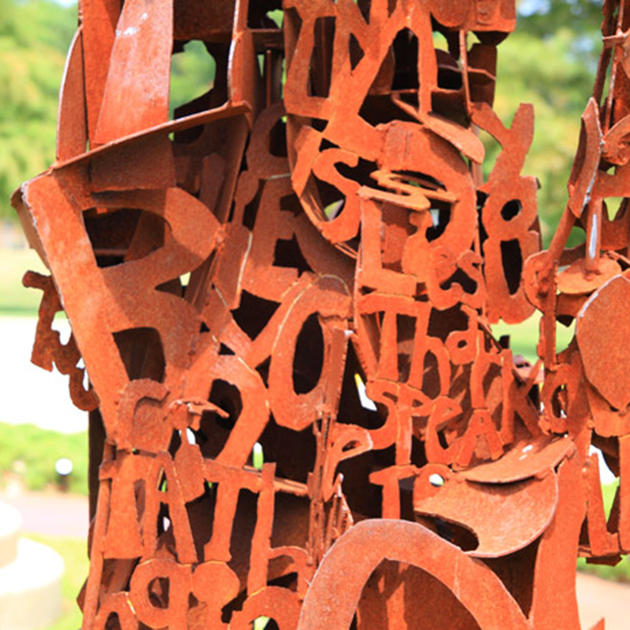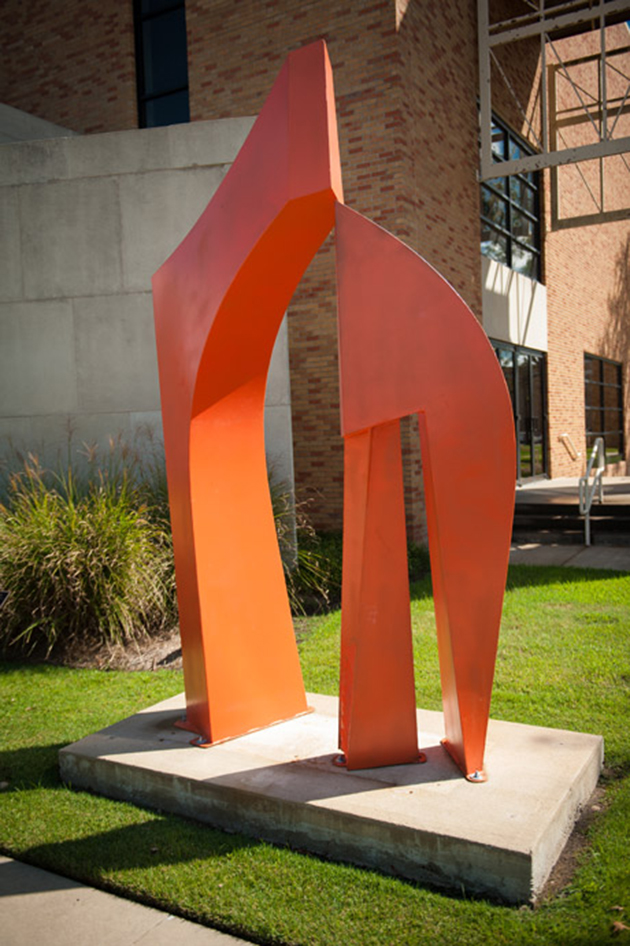HOMETOWN:
Jackson, MO
STUDIO LOCATION:
Batesville, AR
HOW LONG HAVE YOU BEEN SCULPTING?
I have been making objects most of my life. Creating sculpture has been a full-time endeavor for the last seventeen years.
WHAT GOT YOU INTO THIS MEDIUM?
I have made things all my life. Welding and fabricating are second nature to me and proved to be a very complete genre for me to enter into the making of art. Stainless steel is my choice of material for making sculpture due to its capacity to endure the elements of nature. I also like the ability it possesses to reflect the colors of the sky and whatever else happens to surround the pieces.
WHERE DID THE INSPIRATION FOR THIS SELECTED PIECE DERIVE?
The inspiration for a specific piece is a hard thing for me to pin down as they are all a part of a stream. In my work as well as in my life, I am trying to understand the duality of life and find a balancing position between the opposites which coexists in our lives. If I were to try and explain the goal of my sculpture throughout my career, I would say it has been to make something beautiful, which contains opposites, balanced in a moving, yet static composition.
TELL US ABOUT THE CHALLENGES ASSOCIATED WITH CRAFTING THIS PIECE.
The difficulties involved in creating a piece of sculpture usually are generally straightforward problem solving once the project has begun. However, overcoming the question of why to do something which consumes large amounts of time and money without any idea of a knowable outcome is particularly difficult for me. This is a very basic question which requires an answer and/or a bit of rationalization. Another area of difficulty for me is how to maintain a balance between the consumptive nature of creation and the responsibilities of participating in life as a fully functioning human being.
HOW LONG DID IT TAKE YOU TO COMPLETE THIS PIECE?
My pieces generally take between two and three months to create. Each piece requires a good deal of labor. However, the process of completion is rather vague. Is a piece complete just because it is made? Works of art have lives much like us. After the creation stage, one must find someone or somewhere to exhibit the piece and perhaps a buyer who will take care of the sculpture. If someone purchases a piece, I suppose they are then completed. However, even then I am hopeful of good stewardship . . .
HOW DO YOU WANT THE SCULPTURE GARDEN AUDIENCE TO LOOK AT YOUR WORK?
David Smith, the American sculptor, answered this question as well as the question can be answered. He was asked in an interview the question for whom he made his work. The following is his reply and my hope for viewers of my work:
"If you ask for whom do I make art, I will say for all who approach it without prejudice."
(Statement made at a forum held by the New York Herald Tribune and the New York City Board of Education, March 19, 1950.)
To view my work with an open mind and spirit is all I can ask of those seeing my work.
WHAT WOULD YOU HOPE THE AUDIENCE TAKES AWAY FROM YOUR PIECE?
This is a question which leads to another question. What should my hope be? I have thought about this often and have not produced an iron-clad answer. Art in general has the capacity to engage us in unknown ways. From the cave paintings to Pollack's swirling masterpieces and on into today's work, curators and historians have tried to explain to us what to think regarding the viewing of works of art, yet there is no way of being certain about any of it. My most basic, and I feel realistic hope, would be for someone to walk away with a sense of curiosity. The stage of curiosity is the beginning of many good things in our exploration of life.
WHAT OTHER ARTISTS INSPIRE YOU?
The work of other artists is not something in which I find a great deal of inspiration. For me the lives of artists both past and present have proven to be a source for finding direction. The stories of artists’ lives are full of accomplishments, struggles, and tragedies much like everyone's lives. These stories offer insight on how one makes it through the difficulties encountered in living life as well as making art. I have found the close relationships I have made in my career to be the most rewarding aspect of being an artist.
WHY DO YOU DO THE WORK YOU DO?
I began working as a sculptor as a way to participate in life on a larger scale. I live and had lived somewhat of a contemplative life and was looking for ways to engage people and share ideas, thoughts, and feelings. In my early works I was hopeful of expressing my ideas through the meaning of the pieces. As I continue on my journey, my point of view has taken a different path. A piece of sculpture can possess an idea or meaning; however, I question whether any work can express a specific thought without words. To me words are the antithesis of visual art. My work over the last several years has been to try and create things of beauty from which a conversation between the viewers can begin. The purpose of making my work is my way of participating in the conversation of life.
“When I begin creating a concept for public artwork, it is an evolutionary process. The request for proposal generally states the mission of the project and what hopes to be achieved with the public art piece. The journey begins as an artist, the moment I attempt to translate the project concept into a vision that can be realized into sculptural form. When the form is received and understood, then the process is successful and extremely rewarding for everyone involved along the way, and for years to come when one engages with the work of art.”
WHERE DO YOU HAVE OTHER WORKS?
I am represented by Shidoni Gallery and Sculpture Garden in Santa Fe, New Mexico. You will find my work there and on the web at www.steelmeditations.com. In the Mid-South you may view my work in the collection of the city of Hot Springs, Arkansas and in the collection of The Historic Arkansas Museum in Little Rock. My work is in private collections in the Mid-South as well as in private collections around the country.
HOW DO YOU FINANCE THE WORK THAT YOU DO?
I think this question falls under the category of "It's difficult." The making of art requires energy, time, and money. For me the first two are somewhat governed by the lack of or ample supply of the third. Making money to finance my work is basically a constant struggle that requires sales of my work whether it is sculptures or photographs. The demands of being an artist are very inclusive. In order to make the income from sales go as far as possible, I find myself doing much more than making sculpture. The job requirements would read something along these lines: artist, who can also weld and fabricate stainless steel, who also can take photographs of sculpture, who can incorporate the photographs into a basic website design, who can also make presentations, as well as staying in touch with dealers and checking out possibilities for exhibits. Being an artist is a very full-time position for me, which requires commitment and sacrifice from me as well as from the people who surround me.



















